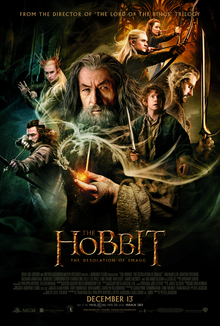The Hobbit: Desolation of Smaug starts off where An Unexpected
Journey bid farewell one year ago with the fellowship of thirteen dwarfs, a
hobbit (Martin Freeman) and a wizard (Ian Mckellen) being tracked by a group of
blood thirsty orcs. Attempting to avoid a number of vicious animals that roam
the forests, mountains and grasslands of Middle Earth the company’s main quest
is to reach the Lonely Mountain, retrieve the Arkenstone and restore Thorin
Oakenshield (Richard Armitage) to the throne. One rather problematic
issue once they get there is the stone is protected by a fire breathing dragon
(voiced by Benedict Cumberbatch) that destroyed the Dwarf city of Dale some time ago.
When news broke that director Peter Jackson was going to split The Hobbit into three different films people questioned how he could spend nine hours (or thereabouts) adapting such a small book. Jackson overcame the issue by inventing characters and adding sequences that were not in the novel. This in itself isn’t too much of an issue (it might be to devotes of the book), but the issue it does create is an overinflated running time. Bagginess is most certainly the biggest issue of the trilogy so far as both films are nearly three hours in length. The Hobbit trilogy seems to lack that special something that made the three hours of each of The Lord of the Rings films fly by.
It is possible that the bagginess of the trilogy stems from the fact that there really isn’t any sense of threat or any sense of danger in which we could lose one of the heroes. It is problematic because it removes dramatic tension from the action set pieces and it becomes a tad tedious every time a character narrowly avoids death. Or perhaps the bagginess is the result of additions to the story made by Jackson and the writers as the addition of Evangeline Lilly’s Tauriel and her possible romance with a dwarf or Legolas (Orlando Bloom) is the most questionable addition to the story. There are pockets of tension peppered throughout the film, like in the forest of Mirkwood (far too little time is spent here as a reliable source informs me that, in the novel, they spend a few months there) and Bilbo’s (Freeman) first baby steps in Smaug’s lair, but the entire dragon set piece at the end of film, whilst being a stunning visual spectacle, does lack that element of tension.
It is possible that the bagginess of the trilogy stems from the fact that there really isn’t any sense of threat or any sense of danger in which we could lose one of the heroes. It is problematic because it removes dramatic tension from the action set pieces and it becomes a tad tedious every time a character narrowly avoids death. Or perhaps the bagginess is the result of additions to the story made by Jackson and the writers as the addition of Evangeline Lilly’s Tauriel and her possible romance with a dwarf or Legolas (Orlando Bloom) is the most questionable addition to the story. There are pockets of tension peppered throughout the film, like in the forest of Mirkwood (far too little time is spent here as a reliable source informs me that, in the novel, they spend a few months there) and Bilbo’s (Freeman) first baby steps in Smaug’s lair, but the entire dragon set piece at the end of film, whilst being a stunning visual spectacle, does lack that element of tension.
Despite the
lack of tension and the occasional bagginess the second part of Bilbo’s journey
has a few great and spectacular moments. The walk through Mirkwood forest is
effective but criminally short and the Harry
Potter like spiders are truly terrifying (though the fight scene itself is
messily filmed). The encounter with Smaug, perhaps the moment the majority of
people were waiting for, is the highlight and certainly does not disappoint. The
dragon is a starling feat of GCI as Smaug’s sheer size, yellow, gleaming eyes
and deafening voice make all descriptions of him fall utterly short of his
enormity. Benedict Cumberbatch’s booming vocal work adds an extra level of
magnificence and awe to Smaug the Stupendous. However, some action set pieces
are too silly to contain any actual threat or danger which contrasts to the Lord of the Rings whose action scenes
were less extravagant (excluding one or two stunts from Legolas) and far more
intense.
One of the
greatest things about the Lord of the
Rings trilogy is the visual spectacle, and yet again the landscapes in The Hobbit: Desolation
of Smaug are a visual feast as the offerings of
visual treats are endless (the Lonely Mountain towering above
all is a highlight). The incredible visuals are responsible
for the influx of tourists visiting New Zealand over the past decade. The 40%
rise in tourism from 2001 to 2006 only highlights how special the visuals are.
A number of things that were impressive about An Unexpected Journey are also impressive here, such as the visuals
and Martin Freeman’s performance as Bilbo, although there is significantly less
attention focused on the hobbit as the attention has been moved to focus on Richard Armitage’s Thorin, and film suffers because of that. Armitage is
fine in the role, but Thorin seems to be a poor man’s Aragorn thus he makes for
a less engaging character than Bilbo. On the more positive side, however, the
issues that the Higher Frame Rate caused in the previous film are no longer an
issue in The Hobbit: Desolation of Smaug.
I am going
against the tide here, but The Hobbit: Desolation
of Smaug is not an improvement over An
Unexpected Journey as a couple of great set pieces do not make a great film
2.5/5




I agree that it's not as good as An Unexpected Journey. It just didn't have the heart and soul of the other films. Great review Myerla :)
ReplyDelete